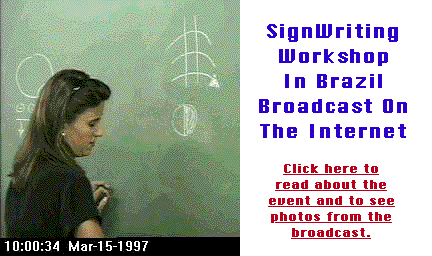In October, 1996, Antonio Carlos da Rocha Costa, a professor
at the Pontificia Universidade Catolica do Rio Grande Do Sul,
Instituto de Informatica (PUCRS), in Porto Alegre, Brazil, started
using the SignWriter
Computer Program to record Brazilian Sign Language with
his students. Here is a description of the Brazilian project
in Antonio's own words...
October 2, 1996
Computer Eduction At The University
"We're mainly in the area of Computer Science, not in
Linguistics, aiming to develop computer applications oriented
to signed languages and Deaf culture. We base our work mainly
on the linguistic research by Dr. Lucinda Ferreira-Britto, from
Rio de Janeiro, which is the main researcher working on Brazilian
Sign Language. At the moment, the Linguistics Department at PUCRS
has the only graduate course here which is open to research on
signed languages I've worked in the areas of Artificial Intelligence
and Theoretical Computer work for years. Recently I approached
the area of "Computers in Education".
Our project concerns what I call "Sign Language Processing",
that is, the application and adaptation of Artificial Intelligence
techniques of "natural language processing" to signed
languages. The aim is to define a computational, internal, symbolic
representation for signed languages able to allow computer programs
to do their usual work on language representations: analysis,
translation, interpretation, etc. We've started working on the
representation of hand configurations. We're trying to solve
now the problem of representing internal hand movements. I've
looked at SignWriting precisely because of that problem. It also
happens that SignWriting may solve another problem we have, namely,
defining an external, graphical representation for signs which
is compatible with our internal representation."
November 19, 1996
Computer MultiMedia Instruction In SignWriting
"Our animated SignWriting icons are quite amazing. We
are developing a simple program to map between photos/drawings
of handshapes (standard brazilian sign handshapes, letters and
numbers), their standard names, their SignWriting representation,
and a simple coding I devised to give internal representations
for handshapes, to allow their manipulation in programs. The
user should be able to do any of the following: to choose a picture
by browsing through the picture set, to type the standard name
of the handshape, to choose a SignWriting handshape by browsing
through the set of SignWriting representations, to give directly
the internal handshape coding, or to assemble the handshape from
pre-defined palm and finger shapes, and then the program should
show the corresponding remaining items, using a simple association
betweem them. Allowing the assembly of handshapes from pre-defined
palm and finger shapes seems to be an interesting device to aid
sign learning."
December 12, 1996
SignWriting In School For Deaf Children
"We have contact with two main schools for deaf children
in our state, Rio Grande do Sul, one in Porto Alegre, which is
the Escola Especial Concordia, the other in Caxias do Sul, a
city two hours distance from Porto Alegre.
Recently my Deaf student Marianne Stumpf, who is a teacher in
the Deaf K-12 school Escola Especial Concordia, told me that
the school director authorized her to prepare the plans for a
regular class on SignWriting, to be taught to 6th and 7th grade
students, starting in 1997. Marianne is very happy. She likes
SignWriting very much. She will also use the SignWriter computer
program in the classes."
January 26, 1997
Children's Story Written In Brazilian Sign Language
"We have translated to sign language, and have edited
it with the help of the SignWriter program, a little book written
by a brazilian Deaf author. The book is entitled A Little Girl Called Kauana and is directed
to little Deaf children, showing them Signed Portuguese, not
Brazilian Sign Language. Marianne translated the book from Signed
Portugues to Brazilian Sign Language, and we replaced figurative
drawings with signs in SignWriting. The result is amazing. We'll
finish the revision process next week.
Marianne will use the book in her classes. If the organization
that printed the book (FENEIS - National Federation for the Education
and Integrations of Deafs) allows us, we will distribute it to
other schools.
We plan to translate the Lessons in SignWriting textbook to Portuguese
and produce examples in the Brazilian Sign Language during 1997,
so Marianne can use it in her classes. We've already translated
chapter 3.
On March 15, 1997, we will organize a workshop for the Deaf people
from our city and our state, to show SignWriting and the SignWriter
program. If everything goes OK, we'll be able to put the meeting
on the Internet.
The folder advertising the meeting is written in sign language.
It was finished in December, and shown to many Deaf people. You
certainly can imagine the impact it caused. They simply loved
it. The meeting promises to be very fruitful.
Best wishes - Antonio Carlos"
